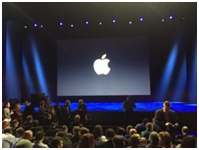Your Trustworthy IP Partner!
One Firm
Multiple Dimensions Services
You are here: Home > Information > Case < Back
An Individual V.S. a Patent Giant?
View: 1864 Date: 2016-09-06 09:58

The invitation for the release conference which is to be held on Sept. 7th tempted the appetite of Apple fans. People have been wondering what new products Apple will release this time. However, outside the conference hall, Apple is in dispute with an invention patentee named Lei Yi over intellectual properties.
As the owner of Chinese invention patent ZL201010232834.7, Lei Yi believes that some features of iMessage on iPhone4 and its subsequent versions violate his patent and took Apple Electronics (Beijing) Co., Ltd. (“Apple (Beijing)”) to the court, requesting an order to cease offering for sale and selling relevant products including iPhone4,4s, 5, 5s, 6 and 6s and to bear all costs of the litigation.
New features igniting disputes
Lei Yi is one of the earliest professionals dedicated to the theoretical research on mobile Internet applications. It is said that the disputed patent technology, i.e. the Dual-mode client and method directing the transition from traditional SMS to the instant messaging service, come out of Lei Yi’s independent research in the field of communications technology.
“In July, 2010, I filed a patent application for this technology and in June, 2013, this application was granted." said Lei Yi.
In June, 2011, Apple released a new operating system of iOS5 with an updated Messages app where a new function of iMessage was added to the previous application "SMS". Messages sent through iMessage will be encased in a blue bubble if iMessage is simultaneously available to the receiver, but if the receiver turns off WiFi and cellular data network, the message then will be sent through the traditional SMS and encased in a green bubble.
Lei Yi believes that Apple's operating system uses the technology claimed by his invention patent without permission, which is an infringement. In August 2013, Lei Yi firstly lodged a lawsuit with Beijing First Intermediate People's Court (BFIPC) and the BFIPC formally received this case on August 22, 2013. On November 1 of the same year, Apple (Beijing) requested an objection of jurisdiction but it was dismissed by the court, and also on that day, Apple (Beijing) filed a petition for invalidating the subject patent with the Patent Reexamination Board (PRB) of the State Intellectual Property Office (SIPO). In July of 2014, the PRB issued a decision holding validation of the challenged patent. After that, Apple (Beijing) filed an administrative litigation with the BFIPC, which is still pending.
During the above proceedings, the BFIPC once held two hearings respectively in February and April of 2014. For the second hearing, Huake Intellectual Property Judicial Authentication Institute (HIPJAI) was jointly selected by the both parties and was then entrusted by the BFIPC for the authentication of this case. In June 2015, the HIPJAI released its expertise report holding that the alleged infringement product does not constitute an act of infringement. After nearly two years of battle, Lei Yi applied to withdraw his complaints and on May 26, 2015, the BFIPC granted his withdrawal.
With the same complaint, Lei Yi again took the Apple (Beijing) to the Beijing Intellectual Property Court (BIPC). On July 23rd, 2015, the court formally accepted the case, and recently the BIPC conducted a public hearing.
On the trial the two parties debated on several disputable issues regarding whether the telephone number is the unique identity of implementing the Dual-mode messaging function for an iPhone, how to determine the ranges of models for the alleged infringing telephones, whether the iMessage falls within the instant messaging category in the patent sense, whether iPhone products extract common data of SMS and instant messaging, whether the SMS and iMessage in iPhone use a unified interface to receive and send messages, and the legitimacy in the "three properties" (i.e. authenticity, relevance, legitimacy) brought forward by the HIPJAI. The fierce debate lasted for three and a half hours, nevertheless, the judge did not draw his conclusion for this trial.
Professionals’ accreditation resolving problems
For this case, both parties are concerned about expertise report issued by the accreditation bodies. In fact, due to the complexity of emerging technologies and other characteristics, when hearing a case which is technically complex, the court will conduct technical evaluation in various ways including judicial identification mode, technology ombudsman mode, expert auxiliary mode, judges consultant mode, technical expert repository mode, and mode of a collegial panel composed of judges with technical background, or alternatively composed of a judge and juries with technical background. Each mode has its own characteristics and advantages.
As the technology is constantly updated, the complexity of the technology is increasingly growing, which brings forth many difficulties to technical appraisal.
(International Affairs Dept. of Leader IP)